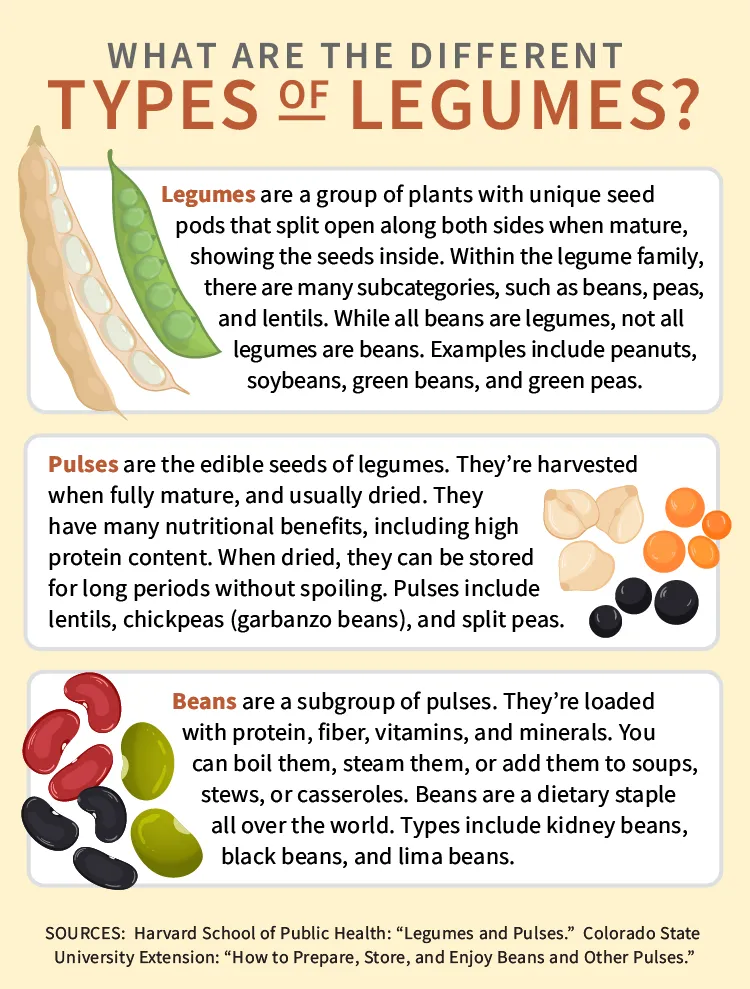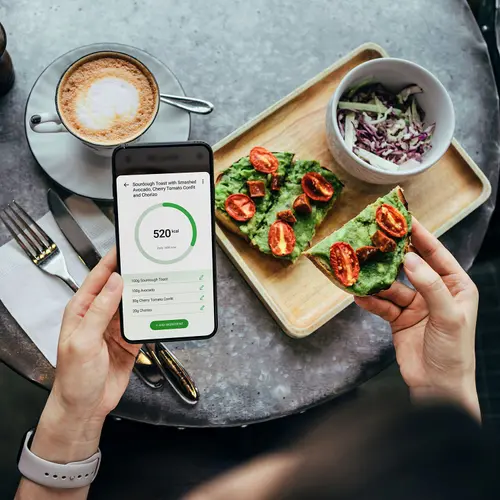What Are Legumes?

Legumes are a type of vegetable. If you've eaten beans or peas, then you've eaten them before. But there are about 16,000 types grown all over the world in different sizes, shapes, colors, and textures.
You can eat green beans and snow peas in their pods, fresh off the vine. With other types, the edible parts are the seeds -- or pulses -- inside the pods. Pulses can be prepared many ways: canned, cooked, dried, frozen whole, ground into flour, or split.
Legumes come from the fabaceae, also called the leguminosae, plant family. It's hard to say where they started. All major cultures grew some type of legume. In Asia, red adzuki beans are crushed into a paste to make sweets. Black beans are popular in Mexico and Brazil. And you'll find white cannellini beans in many Italian dishes.
Some common, good-for-you legumes include:
Chickpeas, also called garbanzo beans
Peanuts
Black beans
Green peas
Lima beans
Kidney beans
Black-eyed peas
Navy beans
Great Northern beans
Pinto beans
Soybeans
Lentils
What Are Beans?
Beans are a type of legume plant seed often used as food. Sometimes you eat the bean pods that contain the seeds, and sometimes just the seeds. Beans come in various sizes, shapes, and colors, and are eaten by various cultures around the world.
Beans are good sources of protein, complex carbohydrates, fiber, vitamins, and minerals. They're low in fat and are considered a healthy food.
You can prepare beans in many ways, including boiling, baking, or sprouting. They can be a main ingredient in dishes like soups, stews, salads, and casseroles or served as a side dish.
What Are Pulses?
Pulses are the edible seeds of legume plants. In other words, all pulses are legumes, but not all legumes are considered pulses. They're generally dried seeds that were harvested from the pods of leguminous plants.
Pulses are an excellent source of protein, dietary fiber, complex carbohydrates, vitamins, and minerals. Pulses include lentils, chickpeas, dry peas, and various types of beans.
Legumes vs. Beans
- Legumes are a family of plants that have the ability to fix nitrogen and produce pods with edible seeds.
- Beans are a type of legume with large, often kidney-shaped, edible seeds.
All beans are legumes, but not all legumes are beans. Beans are one category in a broader group of leguminous plants.
List of Legumes
Some common, good-for-you legumes include:
- Lentils:
- Brown lentils
- Green lentils
- Red lentils
- Black lentils
- French green lentils
- Beluga lentils
- Peas:
- Green peas
- Split peas (green or yellow)
- Snow peas
- Snap peas
- Chickpeas (Garbanzo beans):
- Regular chickpeas
- Kabuli chickpeas (larger variety)
- Desi chickpeas (smaller and darker variety)
- Soybeans:
- Edamame (young, green soybeans)
- Mature soybeans (used to make soy products like tofu, soy milk, and tempeh)
- Lupins (lupini):
- White lupins, or lupini beans (a type of bean popular in the Middle East)
- Blue lupins
- Yellow lupins
- Peanuts:
- They're often thought of as nuts, but peanuts are actually legumes that grow underground.
- Cowpeas:
- Black-eyed peas
- Crowder peas
- Cream peas
- Broad beans (Fava beans)
- Pigeon peas
Health Benefits of Beans
The nutrients in beans provide important health benefits. The antioxidants they contain can help reduce cell damage caused by dangerous molecules called free radicals. In this way, antioxidants can help prevent chronic disease. Dark-colored beans have more of these antioxidants because they have more of the pigments that contain them.
Other health benefits of beans include:
Digestion. Beans are rich in insoluble fiber, which your body can’t digest. Insoluble fiber adds bulk to your stools, reducing problems like constipation. Eating insoluble fiber also helps fuel "good" bacteria in your digestive tract, keeping your digestive system running smoothly.
Lower cancer risk. Beans are a good source of phytonutrients, including antioxidants. These plant nutrients help keep your body working as it should. Some may even help reduce your risk for certain cancers, like breast, colon, and prostate cancer.
Kinds of Beans
Some common types of beans include:
- Kidney beans
- Black beans
- Pinto beans
- Navy beans
- Cannellini beans
- Lima beans
- Adzuki beans
- Mung beans
- Fava beans
- Cranberry beans
Legume Nutrition
The nutritional values for legumes depend on the type.
For example, a half-cup (86 grams) of cooked black beans, boiled with no salt, has:
114 calories
7.6 grams of protein
20 grams of carbohydrates
0.5 grams of fat
0 milligrams of cholesterol
7.5 grams of fiber
1.8 milligrams of iron
128 micrograms of folate
23 milligrams of calcium
305 milligrams of potassium
60 milligrams of magnesium
Legumes are low-fat, contain no cholesterol, and have the same amount of calcium as a glass of milk. They also have:
Lysine, an essential amino acid
Powerful antioxidants called polyphenols
Resistant starch, which along with high fiber content helps keep your blood sugar levels low
Legume Health Benefits
Studies show that when eaten regularly as part of a healthy diet, legumes may help to:
Protect against type 2 diabetes
Improve blood sugar and blood fat control for people who have diabetes
Lower blood pressure and cholesterol
Control weight
Lower your risk of heart disease
Legume Antinutrients
Legumes also have compounds called antinutrients. These can block the way your body absorbs certain nutrients. You can fight that effect by limiting how much of any one food you eat at a time and by eating a variety of healthy foods every day. Antinutrients in legumes include:
Lectins. These can interfere with your absorption of calcium, iron, phosphorus, and zinc.
Phytates (phytic acid). These can lower your body's absorption of iron, zinc, magnesium, and calcium.
Tannins. These can lower your absorption of iron.
Saponins. These can interfere with enzymes that help your body absorbs nutrients.
Legume Preparation and Storage
Beans have carbs called galacto-oligosaccharides (GOS), which may cause gas. You can get rid of most of these by soaking and rinsing dried beans before you cook them. Rinse canned legumes, too. If you’re not used to eating beans, start with small amounts to help your body get used to them.
The lectins in raw or undercooked beans can upset your stomach and cause nausea, diarrhea, and bloating. Because lectins are mostly on the outside of legumes, you can remove them by cooking legumes at a high temperature or soaking them in water for a few hours.
Dried legumes -- except for a few, like lentils and black-eyed peas -- need to be soaked to get them ready to cook. You can cover them in water and refrigerate overnight, or boil and set them aside at room temperature for 1 to 4 hours. To cook, boil them until tender, usually around 45 minutes.
Need them now? Choose a fresh legume that doesn’t need soak time, like peas or fresh lima beans. Or open up a can of beans. Be sure to rinse them before serving.
Store dried legumes in sturdy containers with tight-fitting lids. Keep them out of sunlightin a cool, dry place.
How to prepare beans
There are hundreds of ways beans can be prepared, from baking to boiling to grinding them up.
In the U.S., many types of beans are canned or dried for long-term storage. You can add canned beans directly to recipes, but dried beans require soaking and cooking.
Here are some suggestions to add beans to your diet:
- Add them to soups for extra protein.
- Make bean dip from black and pinto beans.
- Add them to salads.
- Try making bean burgers.
- Toast chickpeas in the oven as a snack.
- Make chili, heavy on the beans.
- Include them in casseroles.

